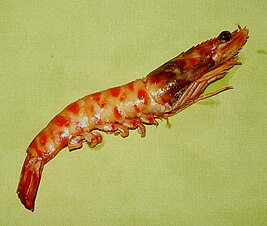| The examples and perspective in this article may not represent a worldwide view of the subject. You may improve this article, discuss the issue on the talk page, or create a new article, as appropriate. (February 2019) (Learn how and when to remove this message) |

Langosta is a Spanish word with different meanings in different areas, most commonly applied to various types of crustacean. In the United States, it is commonly used in the restaurant trade to refer to the meat of the squat lobster, which is neither a true lobster nor a prawn. Squat lobsters are more closely related to porcelain and hermit crabs. Crustaceans labeled as langostino are no more than 8 cm (3 in) long, and weigh no more than 200 g (7 oz). Langostinos are not langoustes (spiny lobsters) despite a similar name (in Spanish, lobster is called langosta). Also, langostinos are sometimes confused with langoustines (Norway lobster).
In the United States, the Food and Drug Administration allows "langostino" to be used as a market name for three species of squat lobster in the family Galatheidae: Cervimunida johni, Munida gregaria, and Pleuroncodes monodon.
In Spain and Venezuela, it means some species of prawns. In Cuba and other Spanish-speaking Caribbean islands, the name langostino is also used to refer to crawfish. In Argentina the name is used to refer to Pleoticus muelleri, a kind of shrimp, while in Chile and Peru it refers to Pleuroncodes monodon.
“Langostino” is the Spanish diminutive of spiny lobster (langosta), which comes from the Latin for locust.
Restaurant labeling controversies
In March 2006, Long John Silver's garnered controversy by offering a dish they called "Buttered Lobster Bites" without making it clear in its advertising that these were made from "langostino lobster." The Federal Trade Commission launched an investigation into deceptive advertising practices by the chain, because Food and Drug Administration regulations require that anyone marketing langostino as lobster must place the qualifier "langostino" adjacent to the word "lobster," and Long John Silver's not only failed to do this, but ran a television commercial making use of an American lobster in a manner that the commission concluded was contributing to the misperception that the product was American lobster.
Upon being contacted by the commission, Long John Silver's promptly terminated the television commercial campaigns, revised its website, and committed both to prominently placing the word "langostino" adjacent to the term "lobster" in all future advertising, and to revising its existing in-store materials accordingly within eight weeks, and on June 24, 2009, the commission wrote to the chain to inform them that they had no intention of taking further action at that time.
Rubio's Restaurants, Inc., settled a 2006 class-action lawsuit for selling "lobster burritos" and "lobster tacos" that were in fact made with squat lobster. The company agreed to change the name to "langostino lobster".
In February 2016, Red Lobster was revealed to have been using a mix of lobster and less-expensive langostino for its lobster bisque.
A 2016 study of American restaurants tested the “lobster” served and found that many were in fact langostino or seafood that were not spiny lobsters.
References
- ^ Schmidt, Catherine (2007). "Fish fraud: no matter what you call it, 'squat' isn't lobster" (PDF). Maine Sea Grant College Program. University of Maine. Retrieved 5 August 2011.
- "Seafood FAQ: Langostino vs. Lobster: What's the difference? | SeafoodSource". www.seafoodsource.com. Retrieved 19 May 2023.
- "FDA Fish List: Market Names of Fish and Shellfish". Archived from the original on 29 September 2007. Retrieved 30 October 2007.
- Holthuis, L. B. (1991). Marine lobsters of the world (PDF). FAO Fisheries Synopsis, no. 125. Vol. 13. Rome: Food and Agriculture Organization of the United Nations. p. 3.
- "Definition of LANGOSTINO". Merriam-Webster. Retrieved 10 February 2024.
- "Taking Aim at 'Impostor Lobster'". CBS News. 4 October 2006. Retrieved 30 October 2007.
- ^ Engle, Mary Kolb (24 June 2009). "Closing Letter to Phillip Allen, Esq. Counsel to Long John Silver's" (PDF). Federal Trade Commission. Retrieved 1 June 2015.
- Horsley, Scott (3 July 2005). "Testing a 'Lobster Impostor' Charge". NPR. Retrieved 9 February 2024.
- "Testing a 'Lobster Impostor' Charge". NPR. 3 July 2005. Retrieved 19 May 2023.
- Bellomo, Rheanna (10 February 2016). "What You Need to Know Before You Eat Lobster This Valentine's Day". Delish.
- Perlman, Merrill (18 June 2018). "Crawfish aren't actually fish. Here's how they got their name". Columbia Journalism Review. Retrieved 10 February 2024.
External links
 The dictionary definition of langostino at Wiktionary
The dictionary definition of langostino at Wiktionary